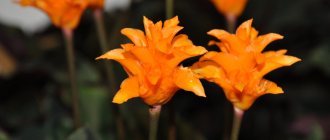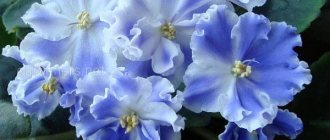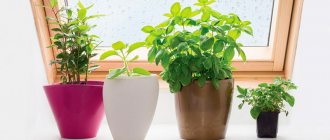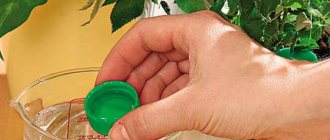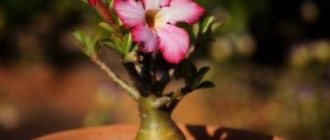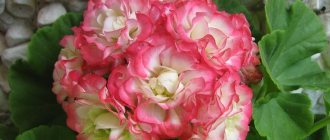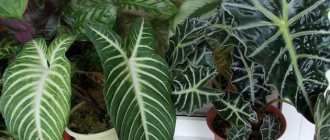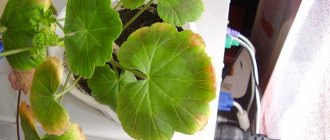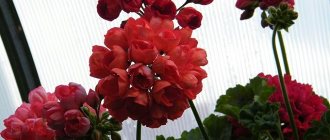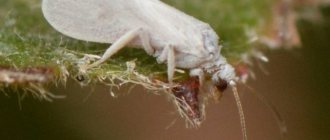Lord Bute
Royal geranium with a very beautiful, velvety dark burgundy tint of inflorescences and pink edging of the petals. The flowers are large, slightly reminiscent of a pansy in shape: the petals are layered on top of each other like a fan.
However, the plant has no odor. The foliage of this species is dense with a jagged edge. Pelargonium reaches a height of 20-30 cm.
This variety is very capricious and fastidious in care. In unsuitable conditions, it can lose all its buds or even die.
You should not expect rapid flowering; it begins in plants that have reached two years of age.
Description of the plant
Geranium got its name because of the shape of the fruit, reminiscent of a crane's beak (translated from Greek geranios - “crane”). In total, the family includes more than 400 species. In the wild it is represented by herbs and shrubs.
Cultivated varieties are very diverse, among them there are miniature (less than 12.5 cm in height) and vigorous (up to 1 m). They are used both for outdoor gardening and landscape design, and for home growing.
In many varieties, flowers are collected in lush inflorescences located on vertical peduncles. Flowers can be simple or double.
The leaves have a characteristic aroma reminiscent of lemon or mint.
Ardens
This variety of pelargonium blooms with peculiar umbrellas with small, neat and sophisticated red flowers and wine veins on the petals. The leaves are large, rich green.
The flower itself grows quite tall, but the main foliage is in its lower part.
Geranium does best in a semi-dark place. It blooms for a long time, but for more beautiful flowering it needs pruning and shaping of the bush.
Homemade geranium - a flower for all times
Dear homemade geraniums bring comfort and warmth to our homes. There are green bushes on the windows with round, soft, fluffy leaves that you just want to stroke, but if you touch them, everything around will be filled with a strong, persistent geranium smell. And how geraniums bloom generously! With careful care - almost all year round! This is a joyful flower.
Among the pelargoniums, colloquially called geraniums, zonal pelargonium is considered the favorite of all peoples in all countries. There are many species in the Geranium family, which includes Pelargonium zonalis, all of which originate from South Africa. These are subtropical plants.
Over time, species, hybrids, and varieties of pelargonium formed 4 garden groups: zonal, large-flowered (royal), ivy-leaved, fragrant.
Westdale Appleblossom
The plant blooms very luxuriantly all season with magnificent large caps consisting of many inflorescences. White buds with a soft pink edging resemble small roses.
At the beginning of the growing season, the bushes need to be shaped by pruning the shoots. And when the “roses” begin to gradually fade, they need to be removed, in which case the entire bunch will continue to bloom.
In addition to flowers, pelargonium has very elegant decorative foliage. Each leaf has a dark green center and a white edge.
This species loves diffused light and warmth. The flower is very picky: it does not tolerate dry air and soil, does not tolerate waterlogging and drafts.
The flower should be grown in spacious pots, but not in open ground. In unsuitable conditions it tends to shed its leaves.
Diseases, pests and problems in growing pelargonium species
One of the main advantages of pelargoniums from among the rare and species is their stability. They very rarely suffer from pests or diseases. With the exception, of course, of rot when the soil is waterlogged, which is especially common in tuberous or succulent species.
In heavy and damp soil, at low temperatures, and insufficient lighting, plants may die from rotting of the base of the shoots.
Pelargonium lanceolatum. © Elena Ioganson
Norrland
Zonal geranium with large double flowers of a deep pink hue. Each of the inflorescences is shaped like peonies.
The bush grows quite tall, but needs to be pruned and shaped. Otherwise, strong and long shoots will grow so much that the plant will lose all its beauty.
The leaves themselves are oval in shape. They are painted in a delicate light greenish tint and are soft to the touch.
The variety is quite unpretentious and can be grown in the garden. It is better to plant pelargonium in partial shade, but the soil should be nutritious and rich in microelements.
Care and maintenance
Pelargonium rosebud was obtained through a process of random mutation and subsequently became the object of serious selection, which led to the emergence of very strong varieties that combine the hereditary characteristics of zonal, ampelous and dwarf varieties.
Requirements for soil and flower pot
Like all pelargoniums, this species prefers small pots, preferably ceramic and not covered with glaze. In such a pot, the soil dries out better and more oxygen reaches the roots. The soil can be purchased at a specialized store or made yourself. It should not be too rich in nutrients and contain components such as sphagnum that can retain moisture. It is better to choose ready-made soil designed specifically for pelargoniums. When purchasing universal soil mixtures, you can add perlite and sand to increase looseness.
You can make good soil yourself. It should include:
- peat soil – 2 parts;
- turf soil - 4 parts;
- river sand – 1 part;
- perlite -1 part;
- leaf humus - 2 parts.
Watering
Watering should be moderate, because pelargoniums suffer most from overwatering and stagnation of water. They can easily tolerate long droughts thanks to their thick leaves that can accumulate and retain moisture.
Illumination
Representatives of pelargonium live well in bright sun and partial shade. They will grow well in a south, south-west and south-east window. In the garden, they can be placed in open rock gardens, hung on balconies and verandas in flowerpots, or planted under the crown in the partial shade of a tree. With a lack of light, the leaves become light, the stems stretch and lose their foliage, flowering will occur later or not at all.
Temperature and humidity
Despite the fact that the plant’s homeland is southern Africa, it has perfectly adapted to indoor and outdoor conditions in the summer. But you shouldn’t expect that pelargonium will feel great in the heat. Temperatures above 28 degrees and bright sun will harm the plant, make it lethargic, and the flowering period will be halved. Delicate petals may fall prematurely.
In winter, like all pelargoniums, geraniums need rest. In order to establish flowering buds, it is necessary to winterize with a temperature drop of up to 10 degrees. The temperature in the room should not exceed 15-16 degrees.
Pelargonium is one of the most undemanding plants in terms of air humidity in the room. It easily tolerates dry air, and in winter, in rare cases, dry edges of the leaf will indicate a lack of humidity. It is not recommended to spray the plant. Droplets accumulate on the hair-covered leaves, which can lead to rot. The plant can be placed on a tray with pebbles and water. The second way to humidify the air is to place it in a larger pot, placing wet moss between the walls.
Fertilizers
Starting from the end of February, the flower is ready to awaken and emerge from the dormant period. At this time, it needs fertilizers containing nitrogen. They will help the formation of lush green mass, branched stems and lush color of greenery. With the third or fourth feeding, the fertilizer should contain more potassium and phosphorus. These minerals help to obtain abundant and long-lasting flowering.
Bush formation
Rosebud pelargonium is pruned twice a year. Autumn formation is the strongest. Old bare shoots are cut off, very elongated shoots are shortened by 2/3 or 1/3. In the spring, before active growth begins, pelargoniums are pinched very carefully. Spring pruning is severe and can delay flowering or eliminate flowers this year.
PAC Viva Maria
Zonal geranium with large double pale pink flowers with a bright crimson center at each petal. The medium-sized leaves have a rich green tint.
Pelargonium blooms on the fifteenth day. Blooms profusely while maintaining a neat appearance.
Geranium does not require constant attention. Care is limited to regular watering, spraying, and a properly selected corner in the room. The flower will feel best in the shady part of the room.
In addition, frequent watering is not required, otherwise the roots may begin to rot. It is enough to lightly moisten the soil as soon as it begins to dry out.
Fairy Phlox
A non-double variety of star geranium with soft pink flowers that look like crouching butterflies.
This interesting shape of the petals resembles real phlox, hence the name of the variety, translated from English as “Magic Phlox”.
Each soft pink flower has a darker center and veins on the petals. The leaves are oval, wide with a bright green tint.
The variety is photophilous and not very picky. In order for the plant to bloom magnificently and beautifully, excess shoots should be removed from the bush.
Denise
A zonal geranium that has stunning flowers that range from soft pink at the ends of the petals to white in the middle.
It blooms in large lush caps, and each bud is shaped like a half-opened rose.
The leaves are wide, bright green. The bushes themselves are not very tall, but quite powerful.
This type of pelargonium loves light, so it should be placed on the sunny side. Otherwise, the plant will shed its leaves and stop blooming. Watering is required regularly, but not very abundant.
History of selection
Geranium seeds were brought to Europe from southern Africa at the beginning of the 17th century. The very first varieties of geraniums appeared in the palace of the English queen with a wonderful winter garden with all kinds of strange plants. Europeans liked this beautiful plant with magnificent flowers.
At the end of the 18th century, geranium appeared in Russia.
It was found in almost every wealthy home. Subsequently, during centuries of selection, over 10,000 varieties of pelargonium of various shapes and colors were bred. Some species remained wild, were able to adapt to the cold Russian climate and grew in the open air.
Aristatum
Pelargonium has unusual flower caps: each inflorescence is shaped like an umbrella with thin petals. Each is cream or pale yellow in color, with the back two petals flecked with wine color. The leaves are small, oval-shaped and deep green.
This type of pelargonium does not require special care. The plant is light-loving, but will also thrive in partial shade. Does not require frequent watering.
Reproduction of pelargonium species
These rare collectible plants are so rarely found on the market that it is often almost impossible to obtain new specimens. Today, species pelargoniums are most often started by growing them from seeds. But if you want to propagate existing unique species, then it is better to choose vegetative methods for this. The thing is that pelargoniums are very easily pollinated. And, if they are grown in collections with other species, it will be almost impossible to obtain “pure” offspring.
The best method for propagating species of pelargonium remains cuttings. In tuberous or stemless species, you can simply separate the daughter nodules from the mother bush. But even for these species, cuttings are preferable.
There is nothing complicated about rooting pelargonium species - it is carried out in the same way as for any varietal plants. You can root cuttings of species geraniums in sand, water, substrate, under or without a hood.
Growing pelargonium species from seeds requires patience and accuracy. Germination can be expected from 1 to 6 months, and sowing should be carried out superficially, in a disinfected light substrate. Bright lighting and stable temperatures around 20 degrees are very important. With any waterlogging, seedlings suffer from rot. It is better to spray them with fungicides for prevention.
